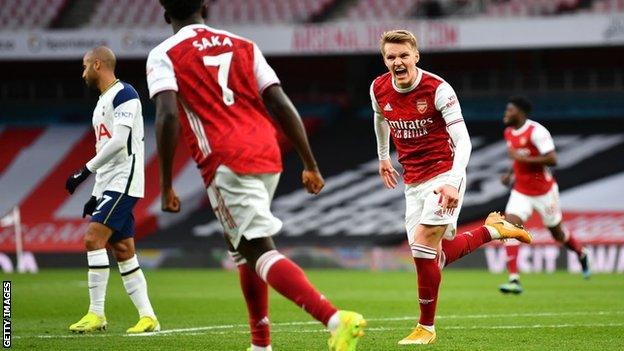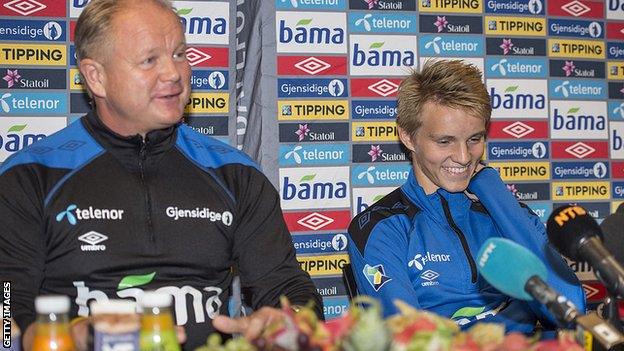Martin Odegaard: Arsenal midfielder reaches crossroads as Real Madrid return looms
- Published
- comments

Martin Odegaard has scored only two goals for Arsenal this season, although one of them did come in a Premier League win over rivals Tottenham
When Martin Odegaard joined Arsenal on loan from Real Madrid in January, it was hoped he would drive them on to Europa League success and a top-four Premier League finish.
Neither of those ambitions has materialised and, with European qualification for next season unlikely, the chances are Arsenal will find it difficult to keep hold of the 22-year-old.
After starting impressively, his progress has been hampered by injury and his playing time has been limited lately.
But there have been flashes of brilliance from the Norway midfielder, reminders of why for so long he has been regarded as a star in the making and why Real Madrid bought him amid much fanfare as a 16-year-old.
So what do those who have played alongside and watched Odegaard think of him? And will we be seeing him in a Real shirt again next season?

Odegaard's signing from Real came at a time when Arsenal were struggling for creativity but, alongside two other exciting young players - Bukayo Saka and Emile Smith Rowe - he has provided moments which suggest he is at home on the big stage.
Manager Mikel Arteta has repeatedly praised Odegaard, both for how quickly he has adapted and also for his leadership skills.
"When everyone was a little bit trembling, he gave us that stability, that composure on the ball and created chance after chance," Arteta said after Odegaard's sparkling performance in a 3-3 draw against West Ham in March.
That was hardly news to fans in Norway, where Odegaard was this year appointed as the national team's captain despite being only 22.
He earned superstar status in his home country long ago. In April 2014, he was picked by Stromsgodset against Aalesunds FK and became the youngest player in Norway's top-flight history at the age of 15 years and 118 days. Just four months later, he made his first appearance for the national team, against United Arab Emirates, becoming Norway's youngest debutant.

Odegaard is 22 but has been playing international football for seven years, having made his Norway debut in 2014
But Odegaard's former team-mates at Stromsgodset knew his potential long before that. The coaches noticed it, too - and made him train with the first team when he had not long turned 13.
"I remember a friendly during that summer [2012]," Hungarian striker Peter Kovacs - 20 years older than Odegaard - tells BBC Sport. "Martin came on as a sub and didn't have any muscles, but he gave me the assist and we drew 2-2.
"From the first training session you could see that the boy had something special. We were experienced guys, but he just fooled us. He was running the show from the first game."
Odegaard was given playing time at Stromsgodset by Ronny Deila, who went on to manage Celtic, and never looked back. Despite being so young, it was his game intelligence that stood him apart.
"I remember a training camp in Spain before the 2014 season when we played against CSKA Moscow," Kovacs adds. "Martin got a ball and suddenly three or four big Russian guys tried to get it off him. I said to myself that he was going to be injured or something. But he just easily came out of the situation. It was amazing to see."
Odegaard started playing football on a gravel pitch in his home town Drammen. Under the watchful eye of his father, Hans Erik, he trained at least 20 hours per week during his childhood - and quickly became better than the older kids around him. After joining Stromsgodset, he continued climbing up the age categories and ended up as a boy in a dressing room full of men.
"The coach told him he would be treated the same as the other players, even if he was so young," Kovacs explains. "When we wanted to tackle him, we would tackle him hard. He would learn the hard way. I believe he benefitted from that. Norwegian football is quite hard and physical. It gave him a good start in his professional life."
Odegaard would turn up to Stromsgodset's training ground just after his school classes ended in the afternoon and then undertake two training sessions and a gym workout before going home.
"He was always 100% in what he needed to do. In his mindset, he was like an older pro," Jarl Andre Storbaek, Stromsgodset's right-back, says. "Kids in Norway don't realise how much it takes to get as good as him. They train maybe for half of that and they think they will be next."
After Odegaard became a full member of Stromsgodset's first team, Storbaek would often meet him at the ground early in the morning. "I was 36 at that time, so I had to come to do some stretching and exercises. Martin came early for the session, too, even though he was only 15. It was me, the oldest guy in the squad, and Martin, the youngest guy, doing preparation early. I realised he was a serious guy who could get just what he wishes."
When Storbaek faced him on the training pitch, he would get a sense of deja vu. Seven years before that, he played for Norway in a friendly game against Argentina and defended against Lionel Messi.
"It was the same feeling when I met Martin," adds Storbaek. "He already had those skills: the right speed of a pass, he could adjust his position to other players, break through the lines, make sprints, change his movement the other way than you thought. He was far better than all the others. During training, he could just run around us. When I defended against him, I always had a feeling that I got him, but no, far from it. He turned another way and he was off."
It was soon clear to everyone Odegaard would not stay in Norway for long. Many European elite clubs became interested, including Bayern Munich, Liverpool and Arsenal. Inevitable comparisons with Messi appeared in the newspapers. However, in January 2015, Real Madrid signed him, paying an initial fee reported by Spanish media to be £2.3m.
The path to Real's first team has proved a tough one, though, and a player destined to be Norway's first global footballing superstar has been surpassed in that regard by Borussia Dortmund striker Erling Braut Haaland.
Carlo Ancelotti gave him his debut in a 7-3 home win against Getafe, coming on as a substitute for Cristiano Ronaldo. "When he debuted in Norway, he came on for me," Kovacs says. "In Madrid, he replaced Ronaldo. I told him: 'Martin, now you have to remember you replaced Ronaldo and myself!'"
Odegaard could not get playing time at the Bernabeu, so he made the first of his loan moves, joining Dutch side Heerenveen in January 2017. It took him some time to adapt there. "At Heerenveen, he was good, but somehow he never fulfilled his potential there," says Dutch football journalist Merijn Slagter.
That changed when Odegaard joined another Eredivisie club - Vitesse. "At Vitesse we saw a better Odegaard. Sometimes he was absolutely brilliant," Slagter adds. "He became one of the best players in the league. He could read the game so well he was always two steps ahead of his opponents, and Ajax wanted to buy him, but it didn't work out."
In summer 2019, Real sent him for another loan to Real Sociedad, and Odegaard impressed. Having become one of the team's leaders, he helped Sociedad into the Copa del Rey final and sixth place in La Liga, earning a Europa League spot. La Real wanted him to return.
But last summer Real manager Zinedine Zidane decided to keep him in Madrid. Odegaard started the first league game of the 2020-21 season, but after he was substituted at half-time against Real Betis, he ended up on the bench. With Toni Kroos and Luka Modric in his position, the chances of getting into the starting XI were limited. Arsenal made their move.

Zinedine Zidane is likely to be a key figure in how Odegaard's career progresses
His impact in England is difficult to gauge. He has been influential at times but, while statistics may only paint part of the picture, his raw numbers do little to suggest he can dislodge Modric and Kroos when he returns to Madrid in the summer: 11 Premier League appearances, one goal, no assists, no big chances created.
Where does it all leave him?
He is happy at Arsenal, feels valued and the Gunners have made a big effort to ensure he knows he is appreciated. The Premier League is held in high regard in Norway, so there is a certain status afforded to those who play in it.
But Odegaard is likely to feel he should be playing European football. There are no other offers on the table at the moment and Real do need to rejuvenate their squad, but the future of Zidane is likely to be crucial.
Zidane clearly decided he could do without Odegaard earlier this season, although it is far from certain the manager will be around next season. Many Real players expect him to leave.
For Odegaard, finding a permanent home where he is appreciated and can play regularly at the highest level is his next major challenge.

'I stole £70,000 to feed my addiction': Meet the young gamblers struggling to overcome betting's mental grip
The Joe Wicks Podcast is back: He talks to Sir Mo Farah on choosing a positive route in life

Additional reporting by Spanish football expert Guillem Balague.